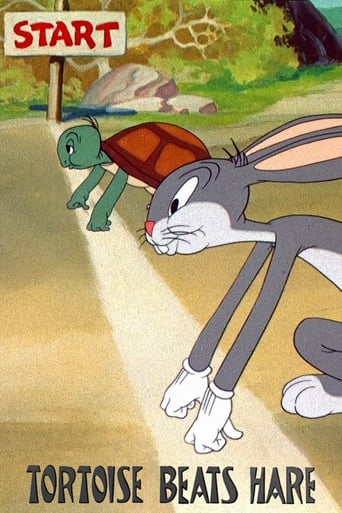phantom_tollbooth
Tex Avery's 'Tortoise Beats Hare' was Bugs Bunny's third cartoon and it established at an early stage what many casual fans of the Warner Bros. cartoons have a hard time accepting; that Bugs isn't always the winner. Although throughout his long career Bugs usually comes out on top there are several fascinating and refreshing cartoons in which he is out-heckled. I love these Bugs-as-loser films because they add more dimensions to the character. 'Tortoise Beats Hare' is one of the best of these cartoons and was popular enough to spawn two sequels, 'Tortoise Wins By A Hare' and 'Rabbit Transit'. The set up for all three cartoons is the same. An egotistical, cocky Bugs challenges Cecil Turtle to a race a la the classic Hare and Tortoise fable. In the other two cartoons, Bugs motivation for this challenge is his past failure against Cecil and a book of fables respectively but in 'Tortoise Beats Hare' the motivation is more original. In one of my favourite sequences in cartoon history, a casual Bugs takes a stroll through the cartoon's opening credits. He reads aloud the names of all the staff involved in making the cartoon (mispronouncing every one) until he finally reaches the title. Enraged by the implication, he tears down the credits to reveal the setting for the cartoons first scene. It's a bravura piece of film-making which boldly plays with cartoon conventions over a decade before 'Duck Amuck' ran with the concept.The race itself, which makes up the main part of the cartoon, is an astonishing example of how to repeat the same gag again and again without diminishing returns. Cecil enlists the help of his many identical relatives to convince Bugs he is being outrun and each time Bugs sees what he assumes is Cecil in the distance, his reaction gets funnier and funnier until the glorious final cringe that interrupts his victory celebrations after crossing the finish line. This concept of milking laughs from mounting disbelief was further explored in Avery's hilarious MGM cartoon 'Northwest Hounded Police' in which Droopy magically appears everywhere the desperate wolf attempts to hide. 'Tortoise Beats Hare' is the first and best of an excellent trilogy. Although it is less talked about than Chuck Jones' Hunting Trilogy, this cartoon at the very least deserves to be mentioned in the same breath.
Lee Eisenberg
Aesop's fable gets brought to life in the first pairing of Bugs Bunny and Cecil Turtle. I guess that you could say that Bugs Bunny has a tendency to let his ego get in the way of everything, especially since Cecil has friends in high - and low - places. A previous reviewer said that Tex Avery helped bring Bugs to his fullest potential here. I don't know whether I fully agree with that, but there's no doubt that Avery (or, as Bugs pronounces it: a-vary) had some neat ideas.Anyway, the title explains how it ends. Some scenes in "Tortoise Beats Hare" were shown in the sequel "Tortoise Wins by a Hare". I suppose that no matter what happens, that'll never be all, folks. At least not for the Looney Tunes.
Robert Reynolds
Although several Warner Brothers directors had a significant hand in the development of Bugs, the one most responsible for setting his personality as the rabbit we know and love (excepting maybe Daffy, Elmer and Yosemite Sam-they don't seem to care for Bugs much) was Tex Avery. This short was an early glimpse of the wascally wabbit as we know him today. Interestingly enough, Avery was responsible for creating Daffy and also the character who evolved into Elmer Fudd (Egghead), so Avery is very much a critical figure for two of the major studios as far as short animation goes. That's why I consider Tex Avery to be the best director of animated shorts and as seminal in their develoment as Walt Disney was to the animated feature film. Well worth seeing. Most recommended.
catradhtem
After Bugs' disastrous second outing, "Elmer's Pet Rabbit," to a point it's nice to see him back with his creative father Tex Avery. However, Tex seems to have forgotten what he did in his first Bugs cartoon to make him successful.In this cartoon, which (and hopefully this isn't spoiling the should-be-obvious plot to anyone) concerns Bugs racing against the slow yet shifty Cecil Turtle, Bugs has changed roles. He is no longer the heckler but the heckled, constantly being outwitted by Cecil at every turn.Perhaps Avery likes the idea of the littler, thought-to-be weaker guy being the wiseacre, regardless of the situation. Sadly, it just doesn't work here as far as sheer character. Of course the gags are hilarious, but Cecil is definitely and knowingly rotten. He makes asides to the camera affirming his cockiness, something Bugs didn't do in "A Wild Hare." In that film, the prey was heckling the hunter for private humiliation, whereas in this one the "prey" is confiding in the audience that he's humiliating his opponent for their benefit. It comes off as a little seedy, so one starts to even root for Bugs to win (even though his arrogance caused the situation in the first place).But at this point Avery, like Chuck Jones before him, is still getting to know his new character and is still figuring out that the jokes work best when Bugs is pulling them on others. Both Tex and Bugs fortunately succeed soon in the future.



